Spring Flower Bulb Guide
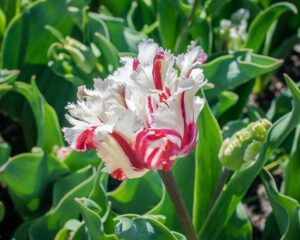
Installing spring flower bulbs in your garden is a great way to kick the spring months off, spring flowering bulbs however are planted during the fall months and will not emerge until the following spring. Although you may not have taken advantage of fall planting you can still fill your spring garden with these flowering beauties. Choose an area that gets plenty of sunlight.
The ideal soil for spring flower bulbs should be loamy which is made up of silt, sand, clay, and organic matter, this type of soil has good water drainage but will hold the right amount of moisture.
There are so many bulbs to choose from and what I love about them is that they are so easy to grow, these 7 listed bulbs will fill your spring garden with amazing colors that are worth your time and your investment.
Affiliate Disclaimer
As an Amazon Associate and the Owner of this Website, I’ve tracked down special deals for some of the products mentioned here. When you use the links on this page to make a purchase I may get a small commission and you will get a great bargain. It’s a WIN-WIN for both of us.
6 Spring Flower Bulbs to Install in Your Garden
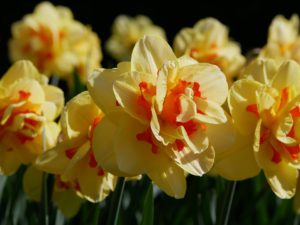
1. Daffodil
The planting location for daffodils should be full sunlight to partial shade but giving them full sunlight will cause daffodils to bloom their best. The soil type should be moist and rich with a pH of slightly acidic to neutral (6.0-70). During the spring and fall months give your daffodils regular watering, once the flowers fade discontinue watering for a month.
Daffodils will bloom even if you don’t fertilize but if the soil type you are growing your daffodils in is poor then applying bone meal or bulb plant food in the top few inches of soil will help greatly. This procedure should be done when the first leaf appears and again when the daffodils flower.
2. Tulips
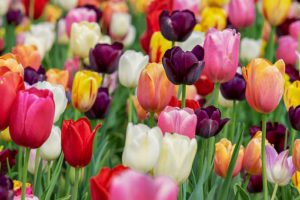
Tulips are so beautiful and will paint your gardens and landscapes with colors that are eye-popping, tulips should be planted in an area that gets full to partial sun. The soil should be sandy because tulips acquire soil that is well-drained with a pH of 6.0-6.5, tulips require very little water because if they receive too much moisture will rot or encourage fungus.
Fertilizing your tulips will keep them looking beautiful, feeding your tulips in the fall is great because this is the time of the year when your bulbs are putting out new roots to prepare for the winter. Spreading one inch of compost over the soil will work wonders.
3. African Iris
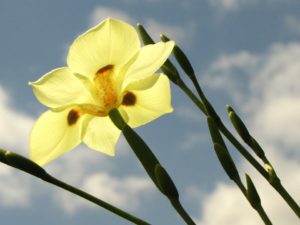
The African iris is a native of South Africa, this garden beauty can be found near marsh areas. I love the iris plant because of the bloom which is a mixture of yellow and purple. Installing a bed of African iris followed by adding a 2-inch of layer wood chips or bark nuggets looks really amazing, install your African iris in an area that gets full sunlight.
The soil should be well-drained soil that will hold the right amount of water but will allow excess moisture to drain through. Adding compost or organic to your existing soil will help to condition the planting area. Give your iris plants a good soaking then allow them to dry out somewhat between watering, African iris should be fertilized in early spring and then again in mid-summer, a fertilizer that contains 10-5-10 is ideal. Before fertilizing your African iris read and follow the manufacturer’s label.
4. Hyacinth
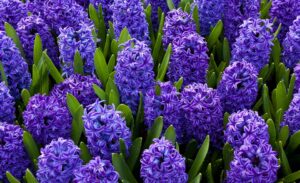
Hyacinth comes in so many different colors, this spring beauty produces some of the most intense fragrant. The flowers of the hyacinth bulb will put on a show for you, and can be planted in the shade but performs better in a sunny location where larger flowers and straighter stems are encouraged. A well-drained loamy fertile soil with a pH of 6.0-7.0 is ideal if the soil must be amended, amend with a few inches of mature compost.
Don’t overwater because hyacinth doesn’t like wet feet, only apply water if the soil is dry at a depth of 3 inches, to encourage flower blooms and a healthy plant. Fertilize hyacinth with 5 tbsp of 10-10-10 water-soluble fertilizer.
5. Crocus
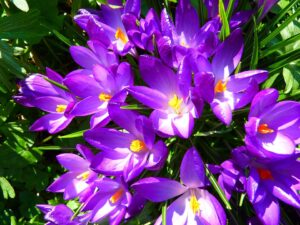
Crocus are low-growing beautiful bulbs that produce an abundance of gorgeous flower blooms in so many colors, these garden beauties can be planted in the full sun or partial sun. Crocus prefers well-drained neutral soil with a pH of 6.0-7.0.
During the growing season ensure crocus receive the equivalent of a half-inch to one inch of water per week, hold off on watering them during the summer months or when they go dormant because rot may set in. Crocus do not require much fertilizing, the energy of this bulb is stored in their corms so avoid the removal or cutting back the leaves until they turn yellow. If the soil you’re working with is poor then adding bulb food or bone meal during the fall months is ideal.
6. Fritillaria Imperial Crown

The fritillaria imperial crown is striking producing unique flowers that are so beautiful, this bulb is a show stopper and is sure to get the attention of anyone. Although fritillaria can survive in light shade the ideal location is an area that gets the full sun. The right soil type is rich well-drained sandy loam soil with a neutral soil pH.
Water well in the fall once bulbs are planted and during the spring months when the plants are growing actively, about an inch of water per week is sufficient. Most fritillaria once dormant prefers dry conditions. At least once a year apply about 1 tablespoon of balanced granular fertilizer around each bulb after plants have bloomed. To avoid damage to the plant’s tissues keep the fertilizer about 2 inches from the stem.
7. Persian Buttercup
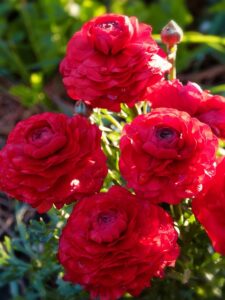
The Persian buttercup is popular for being used as cut flowers in wedding bouquets and floral arrangements, this bulb produces beautiful flower blooms. Persian Buttercup needs about 6 hours of sunlight to thrive, sunlight is needed to encourage flower and foliage growth. Persian buttercup grows best in well-drained loamy or sandy soils with a slightly acidic pH.
If you’re working with heavy clay soils amend it with compost or plant in a raised bed garden, Persian Buttercups don’t like wet feet so only water when the soil begins to dry out. Fertilize your Persian Buttercup after the flowers wither, fertilizers that are rich in phosphorus or potassium are ideal. Make sure to read the directions on the fertilizer label before applying.
The final word on spring flower bulbs
This spring fill your garden with amazing colors with flowering bulbs, bulbs are beautiful plants that deserve our attention, these garden beauties have made a name for themselves because of what they can do. Plant some today you will be happy with the results spring bulbs bring.
About the author
Norman loves being in the garden, both at home and for his job....
he is 'Natures Little helper' being outdoors, growing his vegetables and flowers from an early age.
Now having spent over 22 years in the profession he want to give some of his knowledge to others...
his vast array of hints and tips you will find scattered over this site will help you no end growing plants in your garden.

Thank you for the fantastic article on Spring Flower Bulbs Norman, it is well-written and informative and will be much help to many folks as they get ready to round there gardens into shape with the weather finally warming up with spring’s arrival! There are tulips already coming up around town here so these are obviously an early season bloomer. The Persian Butter cup have a nice full bloom with vibrant colors that remind me of peonies I am so fond of. I agree with you that bulbs deserve our attention for the beauty of flowering bulbs.
Thanks so much for your kind words. I am happy to help.Bulbs are amazing plants.
As a child, I received a crocus bulb at Sunday School every spring to plant. It was supposed to be a symbol of new life. I didn’t really understand, but I loved to plant them and watch them come back each year. As a pastor, I planted a large crocus cross in the lawn in front of the church. It was amazing to see it pop out just as the snow was melting away. We also gave out bulbs. This article has given some alternatives to crosuses.
Wow those memories are so wonderful, thanks so much for stopping by and commenting. I am happy to help.